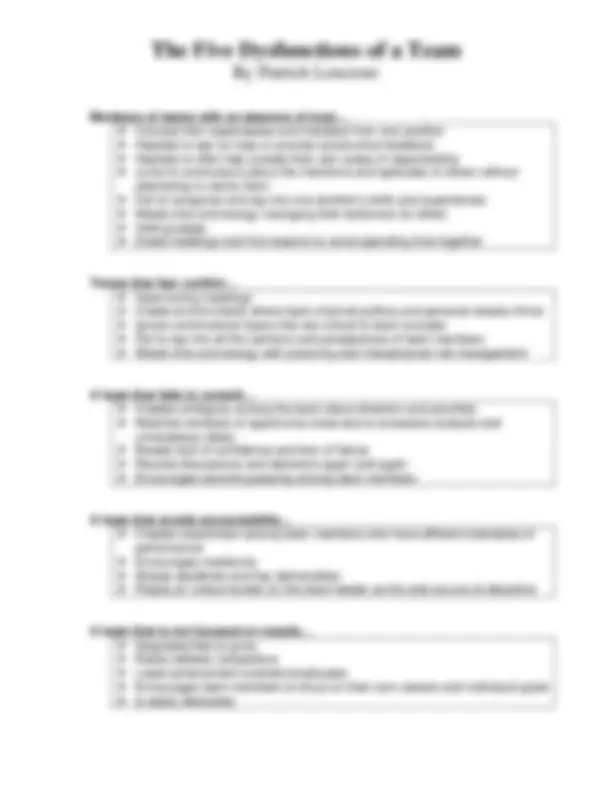



Study with the several resources on Docsity

Earn points by helping other students or get them with a premium plan


Prepare for your exams
Study with the several resources on Docsity

Earn points to download
Earn points by helping other students or get them with a premium plan
Community
Ask the community for help and clear up your study doubts
Discover the best universities in your country according to Docsity users
Free resources
Download our free guides on studying techniques, anxiety management strategies, and thesis advice from Docsity tutors
The Five Dysfunctions of a Team. By Patrick Lencioni. Positive Approach: 1. They trust one another. 2. They engage in unfiltered conflict around ideas.
Typology: Exercises
1 / 3

This page cannot be seen from the preview
Don't miss anything!


Positive Approach:
Inattention to results
Avoidance of ACCOUNTABILITY
Lack of commitment
Fear of CONFLICT
Absence of TRUST
Status and Ego
Low Standards
Ambiguity
Artificial Harmony
Invulnerability
Instructions: Use the scale below to indicate how each statement applies to your team. It is important to evaluate the statements honestly and without over-thinking your answers.
3 = Usually 2 = Sometimes 1 = Rarely
1 Team members are passionate and unguarded in the discussion of issues. 2 Team members call out one another's deficiencies or unproductive behaviors.
3
Team members know what their peers are working on and how they contribute to the collective good of the team.
4
Team members quickly and genuinely apologize to one another when they say or do something inappropriate or possibly damaging to the team.
5
Team members willingly make sacrifices (such as budget, turf, head count) in their departments or areas of expertise for the good of the team. 6 Team members openly admit their weaknesses and mistakes. 7 Team members are compelling, and not boring.
8
Team members leave meetings confident that their peers are completely committed to the decisions that were agreed on, even if there was initial disagreement. 9 Morale is significantly affected by the failure to achieve team goals.
10
During team meetings, the most important and difficult issues are put on the table to be resolved.
11
Team members are deeply concerned about the prospect of letting down their peers.
12
Team members know about one another's personal lives and are comfortable discussing them.
13
Team members end discussions with clear and specific resolutions and calls to action. 14 Team members challenge one another about their plans and approaches.
15
Team members are slow to seek credit for their own contributions, but quick to point out those of others.
Scoring. Combine your scores for the preceding statements as indicated below:
Dysfunction 1: Absence of Trust
Dysfunction 2: Fear of Conflict
Dysfunction 3: Lack of Commitment
Dysfunction 4: Avoidance of Accountability
Dysfunction 5: Inattention to Results Statement 4
Statement 6
Statement 12
Statement 1
Statement 7
Statement 10
Statement 3
Statement 8
Statement 13
Statement 2
Statement 11
Statement 14
Statement 5
Statement 9
Statement 15
Total Total Total Total Total